-
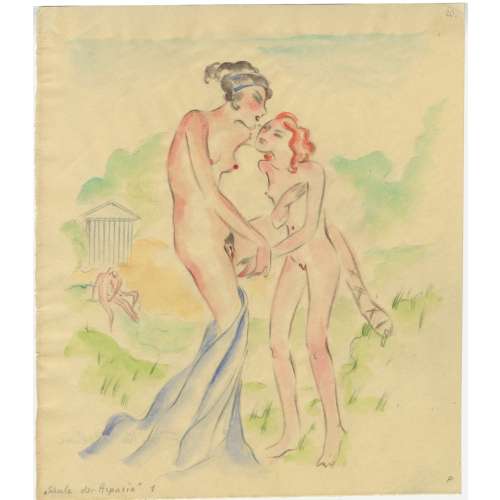 NEWPencil and watercolour on paper 230 x 197 mm, pencil ms inscription in the bottom-left “Schule der Aspasia” 1 (2, 3), monogrammed “P” in the bottom-right, and “Erika Plehn” to verso. Apparently, illustrations for ‘Die Weisheiten der Aspasia’ also known as ‘Die Dirnenschule der Aspasia’ (Aspasia's prostitute school), an erotic novel by Fritz Thurn (Foregger), privately published in Vienna in 1923. Artist: Erika Plehn [née Erika Pinkus] (German, 1904 – 1988) Author: Fritz Thurn [Foregger zum Greiffenthurn] (Austrian, 1877 – 1938). Aspasia of Miletus (Greek, c. 464 BCE – c. 420 BCE)
NEWPencil and watercolour on paper 230 x 197 mm, pencil ms inscription in the bottom-left “Schule der Aspasia” 1 (2, 3), monogrammed “P” in the bottom-right, and “Erika Plehn” to verso. Apparently, illustrations for ‘Die Weisheiten der Aspasia’ also known as ‘Die Dirnenschule der Aspasia’ (Aspasia's prostitute school), an erotic novel by Fritz Thurn (Foregger), privately published in Vienna in 1923. Artist: Erika Plehn [née Erika Pinkus] (German, 1904 – 1988) Author: Fritz Thurn [Foregger zum Greiffenthurn] (Austrian, 1877 – 1938). Aspasia of Miletus (Greek, c. 464 BCE – c. 420 BCE) -
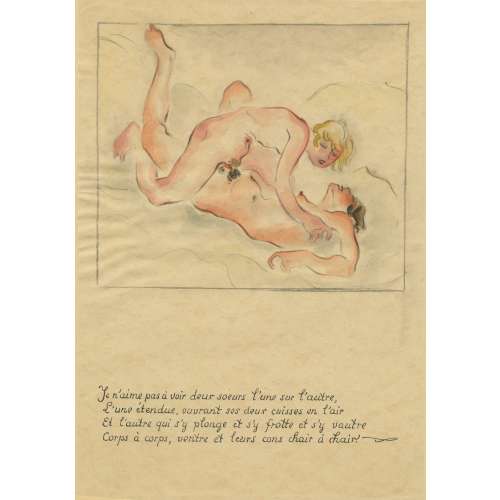 NEWFramed pencil and watercolour drawings with 4-line manuscript pen and ink French text under the frame on paper 255 x 175 mm mounted on card stock sheets 290 x 210 mm. Illustrations correspond to the 1st edition of Pierre Louÿs’ « Pybrac / Poésies » published by Cythère Au coq hardi in 1927 [LIB-3061.2022], pp. 25, 37, 64, 69, 85, 86, and 94. Illustrations here are placed in the order they would have appeared in the book.
NEWFramed pencil and watercolour drawings with 4-line manuscript pen and ink French text under the frame on paper 255 x 175 mm mounted on card stock sheets 290 x 210 mm. Illustrations correspond to the 1st edition of Pierre Louÿs’ « Pybrac / Poésies » published by Cythère Au coq hardi in 1927 [LIB-3061.2022], pp. 25, 37, 64, 69, 85, 86, and 94. Illustrations here are placed in the order they would have appeared in the book.- Je n’aime pas à voir deux sœurs l’une sur l’autre, L’une étendue, ouvrant ses deux cuisses en l’air, Et l’autre qui s’y plonge et s’y frotte et s’y vautre, Corps à corps, ventre à ventre et leurs cons chair à chair.
- Je n’aime pas à voir la douce concubine Qu’on encule toujours et qui, d’un doigt lascif Se branle le bouton, se tire la barbiche, Pour soulager son cul douloureux et passif
- Je n’aime pas à voir cette Sappho mascule Qui, dans sa chambre, habille une fille en garçon, Lui baisse la culotte et froidement l’encule Avec un godmiché plus gros qu’un saucisson.
- Je n’aime pas à voir la vierge au doigt lubrique Qui, les deux pieds en l’air, masturbe sur le lit Son pucelage en rut, gonflé, couleur de brique, Et décharge en baisant le roman qu’elle lit.
- Je n’aime pas à voir le garçon sur la fille Donner des coups au cul et danser le galop Aux applaudissements de toute la famille Qui dit : « Ça vient, putain ! Fais-la jouir, salop ! »
- Je n’aime pas à voir la princesse de Grèce, Qui, menée au bordel par sa fille d’honneur, Frotte sa bouche obscène au cul de la négresse Et crie en déchargeant : « C’est là qu’est le bonheur ! »
- Je n’aime pas à voir dans un bal de familles Que l’hôtesse dispose une chambre d’ami Et des lits de repos, au gré des jeunes filles, Pour sucer leurs danseurs ou se faire mimi.
-
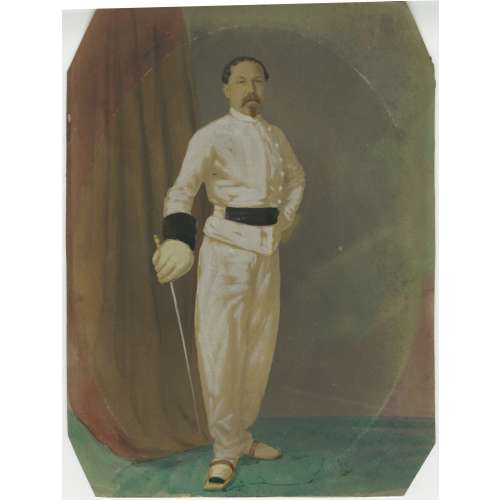 NEWA salt print 208 x 155 mm hand-coloured with watercolours depicting a fencer standing in full gear, mounted on cardboard with all four corners cut out and traces of an oval frame.
NEWA salt print 208 x 155 mm hand-coloured with watercolours depicting a fencer standing in full gear, mounted on cardboard with all four corners cut out and traces of an oval frame. -
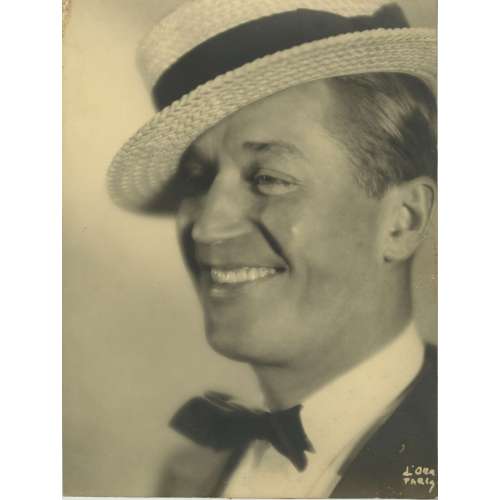 NEWA silver-bromide print 390 x 290 mm depicting actor and singer Maurice Chevalier in a straw hat, smiling, with his head in ¾, facing to the left, dry mounted on cardboard. Signature in white manuscript to the bottom-right corner “d’ORA | PARIS”. Sitter: Chevalier, Maurice Auguste (French, 1888 – 1972) Artist: Kallmus, Dora [Madame d’Ora] (Austrian-Jewish, 1881 – 1963)
NEWA silver-bromide print 390 x 290 mm depicting actor and singer Maurice Chevalier in a straw hat, smiling, with his head in ¾, facing to the left, dry mounted on cardboard. Signature in white manuscript to the bottom-right corner “d’ORA | PARIS”. Sitter: Chevalier, Maurice Auguste (French, 1888 – 1972) Artist: Kallmus, Dora [Madame d’Ora] (Austrian-Jewish, 1881 – 1963) -
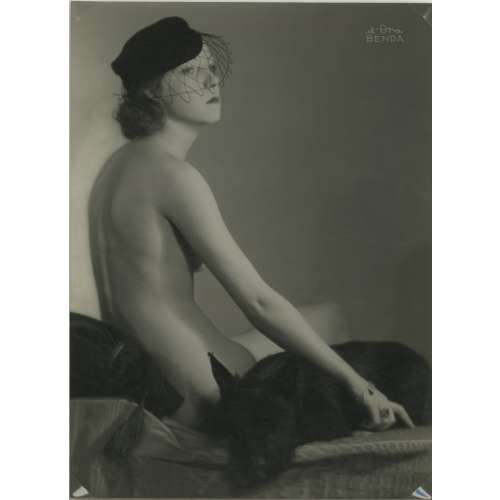 NEWA silver-bromide print 22 x 16 cm depicting a sitting woman, naked, in a veiled hat, with the torso in profile, turning her head ¾ towards the viewer, with a black terrier lying under her right hand. Artist’s device in the top-right corner: “d'Ora | Benda”. According to the seller, it is a portrait of Lisa Petersen, a nude dancer. Artist: Kallmus, Dora [Madame d’Ora] (Austrian-Jewish, 1881 – 1963)
NEWA silver-bromide print 22 x 16 cm depicting a sitting woman, naked, in a veiled hat, with the torso in profile, turning her head ¾ towards the viewer, with a black terrier lying under her right hand. Artist’s device in the top-right corner: “d'Ora | Benda”. According to the seller, it is a portrait of Lisa Petersen, a nude dancer. Artist: Kallmus, Dora [Madame d’Ora] (Austrian-Jewish, 1881 – 1963) -
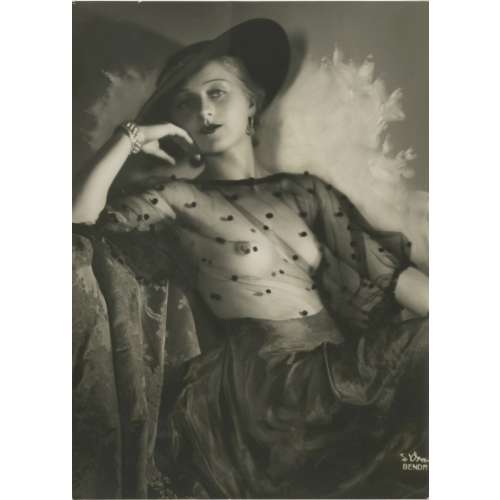 NEWGelatin silver print 212 x 153 mm depicting a sitting woman in a dress with a dotted sheer top and exposed chest, in a hat, with the torso in ¾, turning her head to face the viewer and supporting her head with her right hand. Artist’s device in the bottom-right corner: “d'Ora | Benda”. This is likely a portrait of a Parisian milliner, Madame Agnès, i.e. Agnès Rittener (French, d. 1949).Verso: Blue ink stamp: Copyright | d'ORA | Wien, I. | Arthur Benda | 14160 (ms pencil) || Below pasted a label with blue lettering, framed: AG. SCHOSTAL PARIS | 81, RUE BLANCHE | TEL. TRINITÉ 23.05 | № 7835 (ms red pencil) / WIEN | STARHEMBERGG. 26 | TEL. U-42-0-81 | № 48283 (ms graphite pencil) / MILANO | VIA VIVAIO 24 | Tel. 24,244 | № BEI VERÖFFENTLICHUNG ZU NENNEN: | PLEASE ACKNOWLEDGE: MENTION OBLIGATOIRE: MENZIONE OBBLIGATORIA: | d'Ora Benda, Wien (SCHOSTAL) || Agentur Schostal was an Austrian press photo agency named after its founder, Robert Franz Schostal (German, 1906 - c. 1973). Artist: Kallmus, Dora [Madame d’Ora] (Austrian-Jewish, 1881 – 1963)
NEWGelatin silver print 212 x 153 mm depicting a sitting woman in a dress with a dotted sheer top and exposed chest, in a hat, with the torso in ¾, turning her head to face the viewer and supporting her head with her right hand. Artist’s device in the bottom-right corner: “d'Ora | Benda”. This is likely a portrait of a Parisian milliner, Madame Agnès, i.e. Agnès Rittener (French, d. 1949).Verso: Blue ink stamp: Copyright | d'ORA | Wien, I. | Arthur Benda | 14160 (ms pencil) || Below pasted a label with blue lettering, framed: AG. SCHOSTAL PARIS | 81, RUE BLANCHE | TEL. TRINITÉ 23.05 | № 7835 (ms red pencil) / WIEN | STARHEMBERGG. 26 | TEL. U-42-0-81 | № 48283 (ms graphite pencil) / MILANO | VIA VIVAIO 24 | Tel. 24,244 | № BEI VERÖFFENTLICHUNG ZU NENNEN: | PLEASE ACKNOWLEDGE: MENTION OBLIGATOIRE: MENZIONE OBBLIGATORIA: | d'Ora Benda, Wien (SCHOSTAL) || Agentur Schostal was an Austrian press photo agency named after its founder, Robert Franz Schostal (German, 1906 - c. 1973). Artist: Kallmus, Dora [Madame d’Ora] (Austrian-Jewish, 1881 – 1963)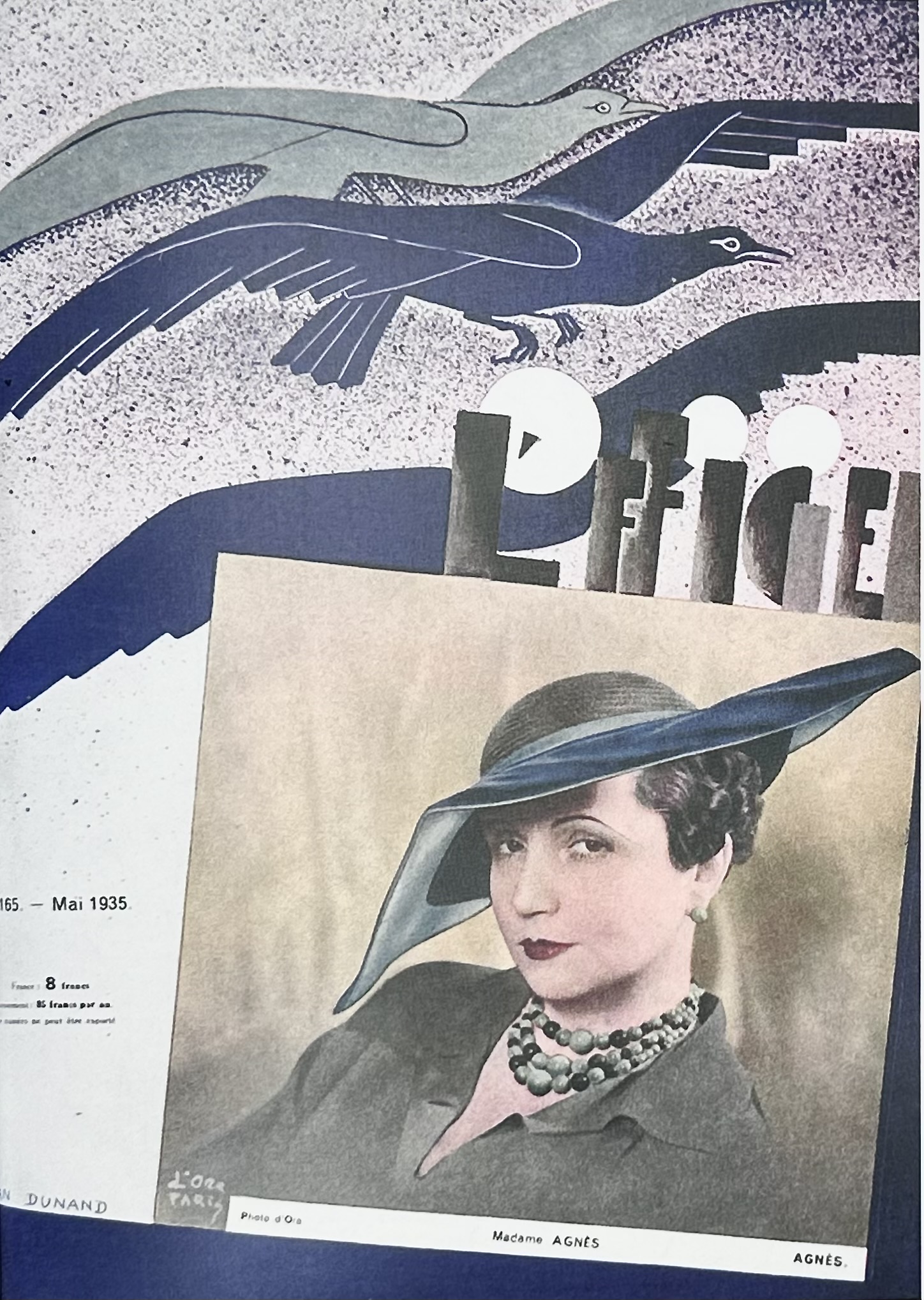
LIB-3351.2024 Madame d’Ora / edited by Monika Faber. – Munich, London, NY: Prestel Verlag / Neue Galerie, 2020, p.101.
-
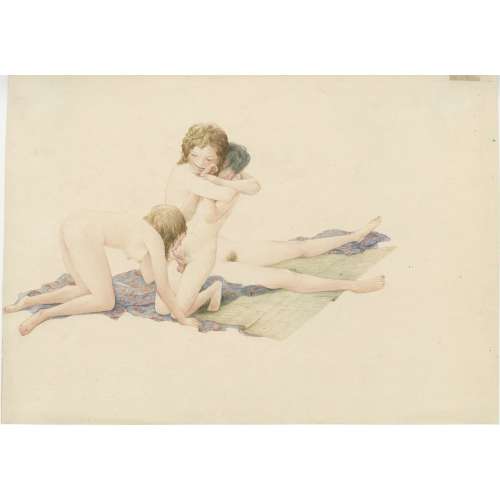 NEWWatercolour on paper, 205 x 292 mm; fuchsia ink stamp "ARS EROTICA | Hans-J. Döpp" to verso, remains of hinges. Untitled. Artist: Otto Rudolf Schatz (Austrian, 1900 – 1961).
NEWWatercolour on paper, 205 x 292 mm; fuchsia ink stamp "ARS EROTICA | Hans-J. Döpp" to verso, remains of hinges. Untitled. Artist: Otto Rudolf Schatz (Austrian, 1900 – 1961). -
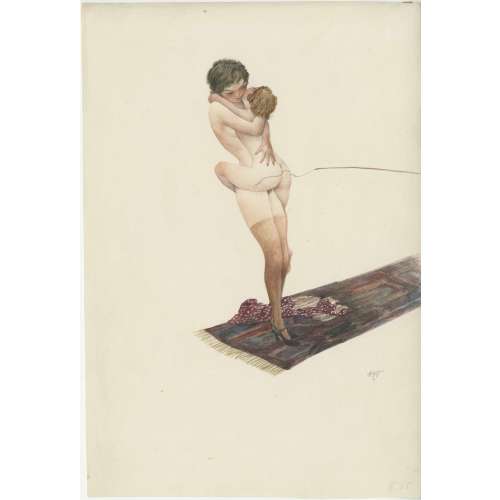 NEWWatercolour on paper, 299 x 205 mm, monogrammed "ORSx" under the image; to verso: blue ink Hungarian export mark "KIVITELRE ENGEDELYEZVE O. Sz. M." and fuchsia ink stamp ARS EROTICA | Hans-J. Döpp. Untitled. Artist: Otto Rudolf Schatz (Austrian, 1900 – 1961).
NEWWatercolour on paper, 299 x 205 mm, monogrammed "ORSx" under the image; to verso: blue ink Hungarian export mark "KIVITELRE ENGEDELYEZVE O. Sz. M." and fuchsia ink stamp ARS EROTICA | Hans-J. Döpp. Untitled. Artist: Otto Rudolf Schatz (Austrian, 1900 – 1961). -
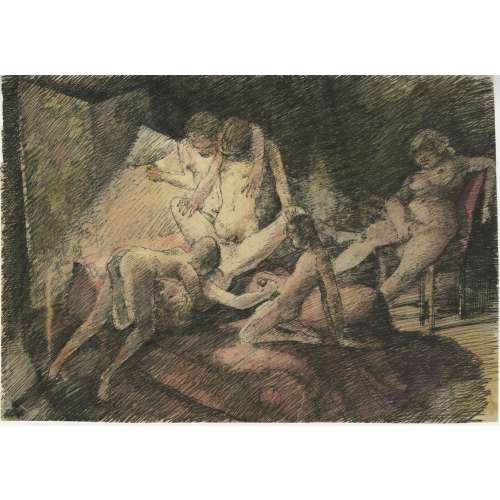 NEWWatercolour, pen and ink on paper, 195 x 282 mm; to verso: black ink stamp “Nachlaß O R SCHATZ" and fuchsia ink stamp ARS EROTICA | Hans-J. Döpp; traces of mounting and repair. Untitled. Artist: Otto Rudolf Schatz (Austrian, 1900 – 1961).
NEWWatercolour, pen and ink on paper, 195 x 282 mm; to verso: black ink stamp “Nachlaß O R SCHATZ" and fuchsia ink stamp ARS EROTICA | Hans-J. Döpp; traces of mounting and repair. Untitled. Artist: Otto Rudolf Schatz (Austrian, 1900 – 1961). -
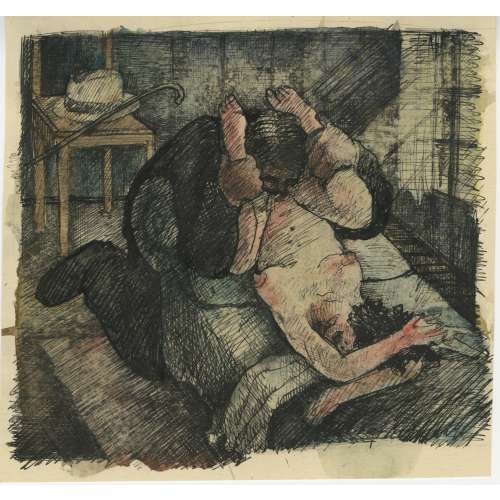 NEWWatercolour, India ink, pen and ink on card stock, 165 x 174 mm; to verso: black ink stamp “Nachlaß O R SCHATZ" and fuchsia ink stamp ARS EROTICA | Hans-J. Döpp; traces of mounting. Untitled. Artist: Otto Rudolf Schatz (Austrian, 1900 – 1961).
NEWWatercolour, India ink, pen and ink on card stock, 165 x 174 mm; to verso: black ink stamp “Nachlaß O R SCHATZ" and fuchsia ink stamp ARS EROTICA | Hans-J. Döpp; traces of mounting. Untitled. Artist: Otto Rudolf Schatz (Austrian, 1900 – 1961). -
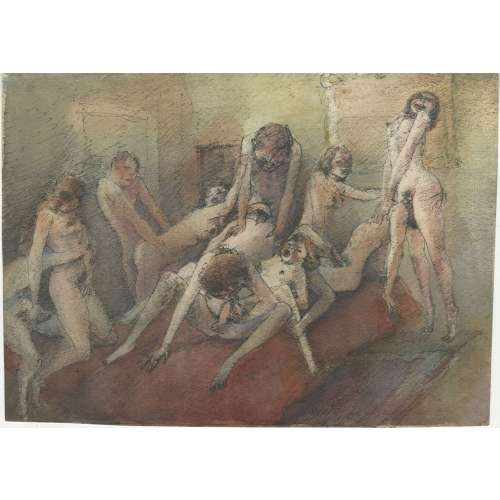 NEWWatercolour, pen and black ink on card stock, 179 x 247 mm; pencil inscription to verso "Otto Rudolf Schatz 3233-03", traces of mounting. Untitled. Artist: Otto Rudolf Schatz (Austrian, 1900 – 1961).
NEWWatercolour, pen and black ink on card stock, 179 x 247 mm; pencil inscription to verso "Otto Rudolf Schatz 3233-03", traces of mounting. Untitled. Artist: Otto Rudolf Schatz (Austrian, 1900 – 1961). -
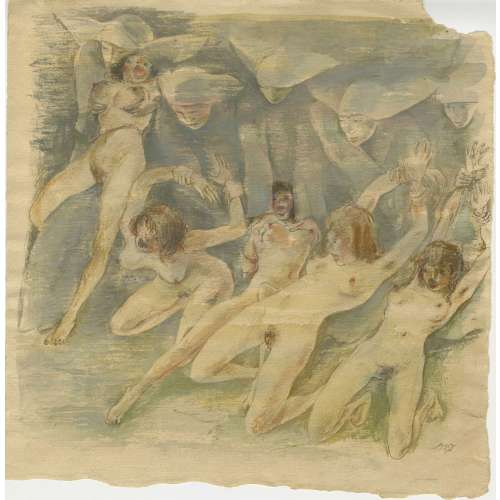 NEWWatercolour, pen and ink wash on thick wove paper, 295 x 298 mm, monogrammed in the bottom right corner "ORSx"; pencil inscription to verso "Um 1950 Otto Rudolf Schatz 3233-03"; two margins cut, traces of mounting on top margin. Untitled. Artist: Otto Rudolf Schatz (Austrian, 1900 – 1961).
NEWWatercolour, pen and ink wash on thick wove paper, 295 x 298 mm, monogrammed in the bottom right corner "ORSx"; pencil inscription to verso "Um 1950 Otto Rudolf Schatz 3233-03"; two margins cut, traces of mounting on top margin. Untitled. Artist: Otto Rudolf Schatz (Austrian, 1900 – 1961). -
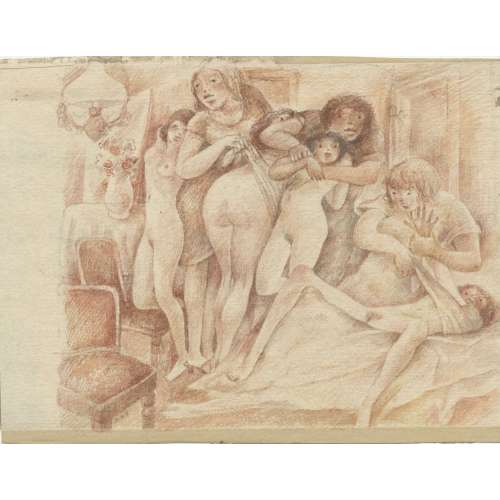 NEWWatercolour, pen and ink on thick wove paper, 177 x 235 mm; to verso: blue ink stamp “Nachlaß O R SCHATZ" and fuchsia ink stamp ARS EROTICA | Hans-J. Döpp; traces of framing along all the margins; traces of framing along the margins; remains of hinges. Artist: Otto Rudolf Schatz (Austrian, 1900 – 1961).
NEWWatercolour, pen and ink on thick wove paper, 177 x 235 mm; to verso: blue ink stamp “Nachlaß O R SCHATZ" and fuchsia ink stamp ARS EROTICA | Hans-J. Döpp; traces of framing along all the margins; traces of framing along the margins; remains of hinges. Artist: Otto Rudolf Schatz (Austrian, 1900 – 1961). -
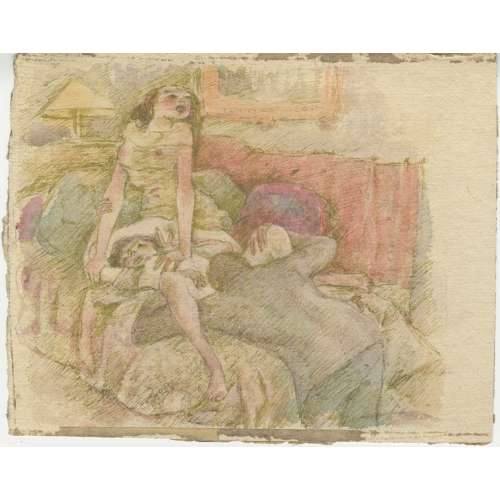 NEWWatercolour, pen and ink on thick wove paper, 180 x 220 mm; to verso: blue ink stamp “PROF O. R. SCHATZ | Wien II, Gr. Mohreng 3b | Tel.: 55 82 566”; fuchsia ink stamp "ARS EROTICA | Hans-J. Döpp"; traces of framing along the margins. Artist: Otto Rudolf Schatz (Austrian, 1900 – 1961).
NEWWatercolour, pen and ink on thick wove paper, 180 x 220 mm; to verso: blue ink stamp “PROF O. R. SCHATZ | Wien II, Gr. Mohreng 3b | Tel.: 55 82 566”; fuchsia ink stamp "ARS EROTICA | Hans-J. Döpp"; traces of framing along the margins. Artist: Otto Rudolf Schatz (Austrian, 1900 – 1961). -
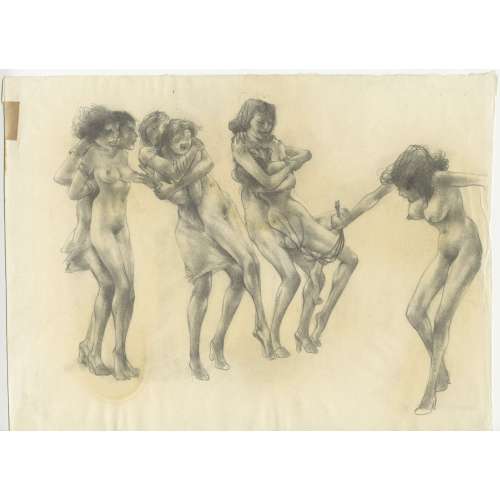 NEWGraphite on wove paper, 250 x 340 mm, blue ink stamp to verso: “Nachlaß O R SCHATZ"; margins trimmed unevenly, traces of hinges. Artist: Otto Rudolf Schatz (Austrian, 1900 – 1961).
NEWGraphite on wove paper, 250 x 340 mm, blue ink stamp to verso: “Nachlaß O R SCHATZ"; margins trimmed unevenly, traces of hinges. Artist: Otto Rudolf Schatz (Austrian, 1900 – 1961). -
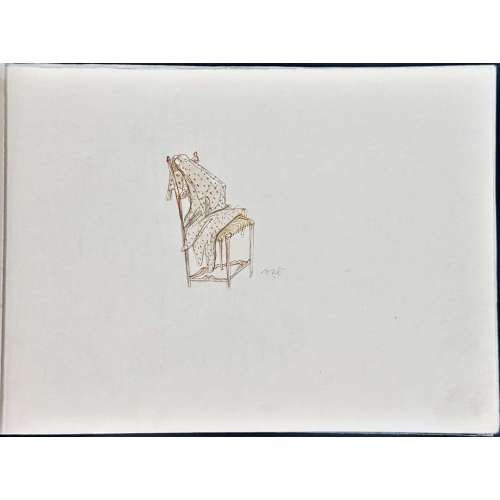 NEWJapanese-style bound oblong horizontal album of 20 colour drawings (watercolour and pencil on paper), 187 x 269 mm, monogrammed on the first page ORS, signed and dated on the last page O. R. SCHATZ | 1954 | x || Artist: Otto Rudolf Schatz (Austrian, 1900 – 1961).
NEWJapanese-style bound oblong horizontal album of 20 colour drawings (watercolour and pencil on paper), 187 x 269 mm, monogrammed on the first page ORS, signed and dated on the last page O. R. SCHATZ | 1954 | x || Artist: Otto Rudolf Schatz (Austrian, 1900 – 1961). -
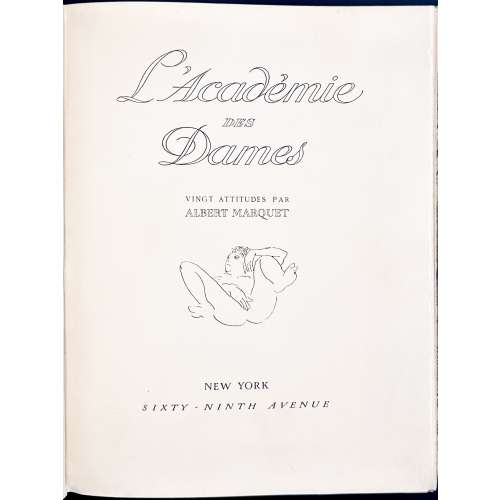 NEWHardcover, 330 x 255 mm, marble paper, two labels of black calf with gilt lettering to spine, 2 blank leaves at front and 2 at back (laid paper), two leaves of lithographic vignettes (t.p. and limitation), plus 20 lithographic plates signed “am”, unpaginated. Limited edition of 25 copies on Japon Impérial paper №№ 1-25, 300 copies on Vélin d’Arches №№ 26-325, of which this is copy № 206. Stones sanded. A poem by Verlaine at p. 2 recto. Title-page: L'Académie | DES | Dames | VINGT ATTITUDES PAR | ALBERT MARQUET | {vignette} | NEW YORK | SIXTY-NINTH AVENUE || Imprint: ÉDITION PRIVÉE | EXEMPLAIRE NUMERO 206 Limitation: JUSTIFICATION DU TIRAGE | IL A ÉTÉ TIRÉ DE CET OUVRAGE | VINGT-CINQ EXEMPLAIRES SUR JAPON IMPÉRIAL | NUMÉROTÉS DE 1 à 25 | ET TROIS CENTS EXEMPLAIRES SUR VÉLIN D'ARCHES | NUMÉROTÉS DE 26 à 325 | PIERRES BIFFÉES || Catalogue raisonné: Dutel III № 949; Nordmann I № 255. Provenance: From the collection of Hans-Jürgen Döpp, Frankfurt. Contributors: Albert Marquet (French, 1875 – 1947) Verlaine, Paul (French, 1844 – 1896) One additional lithographic plate by Marquet from a different source but on a similar subject is laid in.
NEWHardcover, 330 x 255 mm, marble paper, two labels of black calf with gilt lettering to spine, 2 blank leaves at front and 2 at back (laid paper), two leaves of lithographic vignettes (t.p. and limitation), plus 20 lithographic plates signed “am”, unpaginated. Limited edition of 25 copies on Japon Impérial paper №№ 1-25, 300 copies on Vélin d’Arches №№ 26-325, of which this is copy № 206. Stones sanded. A poem by Verlaine at p. 2 recto. Title-page: L'Académie | DES | Dames | VINGT ATTITUDES PAR | ALBERT MARQUET | {vignette} | NEW YORK | SIXTY-NINTH AVENUE || Imprint: ÉDITION PRIVÉE | EXEMPLAIRE NUMERO 206 Limitation: JUSTIFICATION DU TIRAGE | IL A ÉTÉ TIRÉ DE CET OUVRAGE | VINGT-CINQ EXEMPLAIRES SUR JAPON IMPÉRIAL | NUMÉROTÉS DE 1 à 25 | ET TROIS CENTS EXEMPLAIRES SUR VÉLIN D'ARCHES | NUMÉROTÉS DE 26 à 325 | PIERRES BIFFÉES || Catalogue raisonné: Dutel III № 949; Nordmann I № 255. Provenance: From the collection of Hans-Jürgen Döpp, Frankfurt. Contributors: Albert Marquet (French, 1875 – 1947) Verlaine, Paul (French, 1844 – 1896) One additional lithographic plate by Marquet from a different source but on a similar subject is laid in.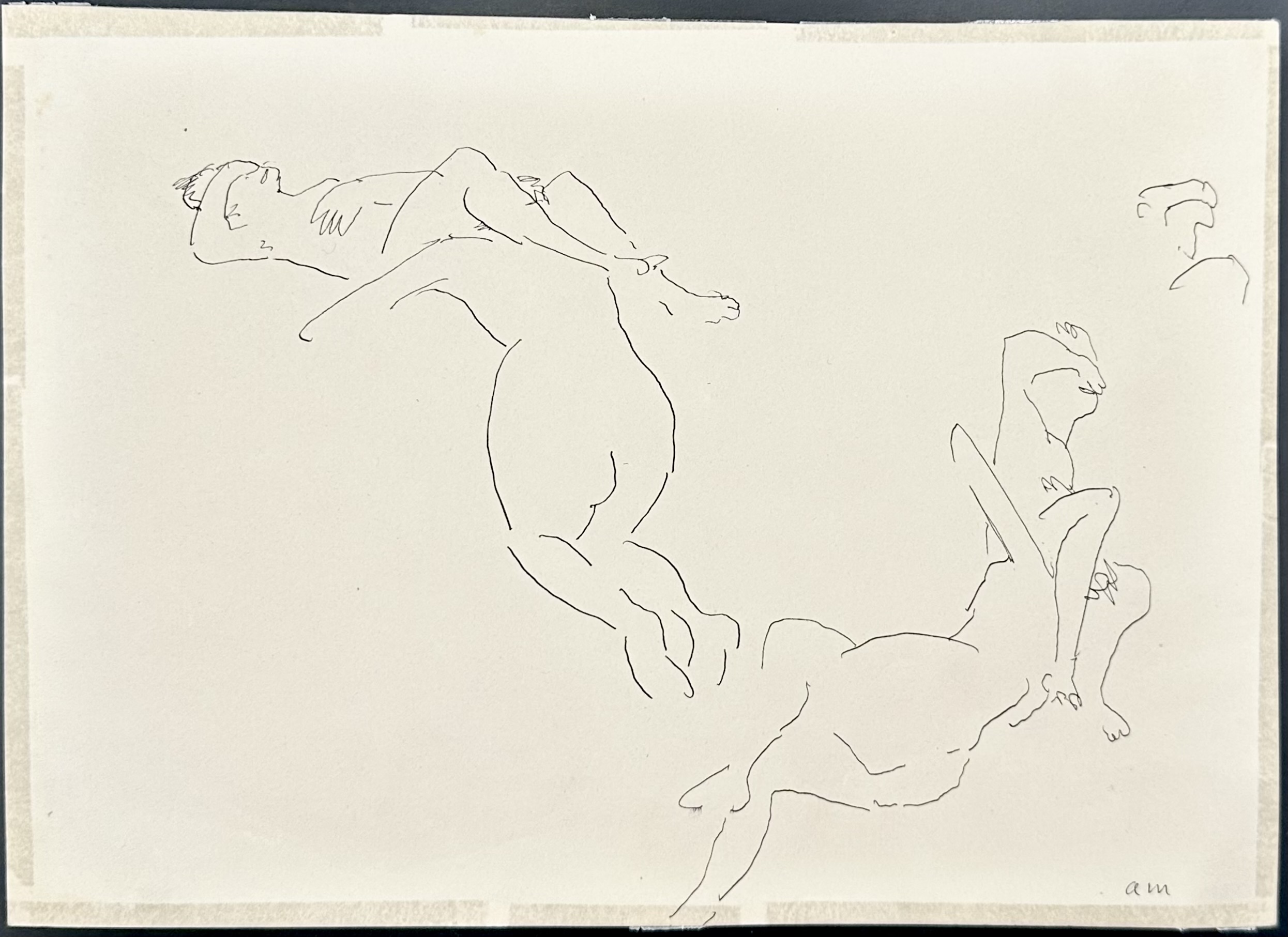
-
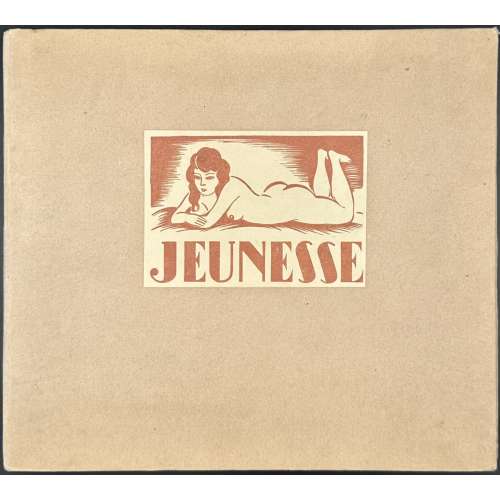 NEWCardboard folder with title label to front, 23.5 x 26.3 cm, containing 12 hand-coloured soft-ground etchings by André Collot, unbound, in a paper folder with pink lettering and vignette engraved on wood, with a title-page in black: JEUNESSE | 12 VERNIS MOUS COLORIÉS | tires à exemplaires | réservés aux Amis de l’Artiste | 1933 || in a frame. First edition, limited to 60 copies. Dutel 1920-70: 1786. There is another copy of the same without the cardboard folder SVE-0469.2021.
NEWCardboard folder with title label to front, 23.5 x 26.3 cm, containing 12 hand-coloured soft-ground etchings by André Collot, unbound, in a paper folder with pink lettering and vignette engraved on wood, with a title-page in black: JEUNESSE | 12 VERNIS MOUS COLORIÉS | tires à exemplaires | réservés aux Amis de l’Artiste | 1933 || in a frame. First edition, limited to 60 copies. Dutel 1920-70: 1786. There is another copy of the same without the cardboard folder SVE-0469.2021. -
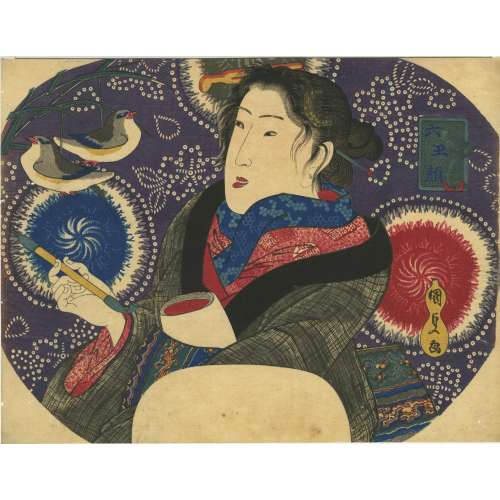 NEWArtist: Utagawa Kunisada [歌川 国貞], a.k.a. Utagawa Toyokuni III [三代 歌川 豊国] (Japanese, 1786 – 1865). Signed: Toyokuni ga [豊国 画] in a yellow double-gourd. Publisher unknown. Media: Untrimmed fan print (uchiwa-e), 228 x 298 mm. Series title: Six Jewel Faces (六玉颜, mu tama-gao), a pun on Six Jewel Rivers (六玉河, Mu Tamagawa). The date seal and censor seal are absent. Another print from the same series in the Metropolitan Museum of New York reads:
NEWArtist: Utagawa Kunisada [歌川 国貞], a.k.a. Utagawa Toyokuni III [三代 歌川 豊国] (Japanese, 1786 – 1865). Signed: Toyokuni ga [豊国 画] in a yellow double-gourd. Publisher unknown. Media: Untrimmed fan print (uchiwa-e), 228 x 298 mm. Series title: Six Jewel Faces (六玉颜, mu tama-gao), a pun on Six Jewel Rivers (六玉河, Mu Tamagawa). The date seal and censor seal are absent. Another print from the same series in the Metropolitan Museum of New York reads:The colorful background, with explosions of tie-dyed floral motifs, is a reminder of how Kunisada made all his thousands of Genji-print designs a visual record of different textile patterns of the day. The title Six Jewel Faces (Mu tama-gao), along with its allusion to the literary theme of Six Jewel Rivers, suggests that this set of fan prints captures the appearance of a half-dozen attractive individuals, and, indeed, the other five works in the set show images of beautiful women, mostly courtesans of the pleasure quarters.
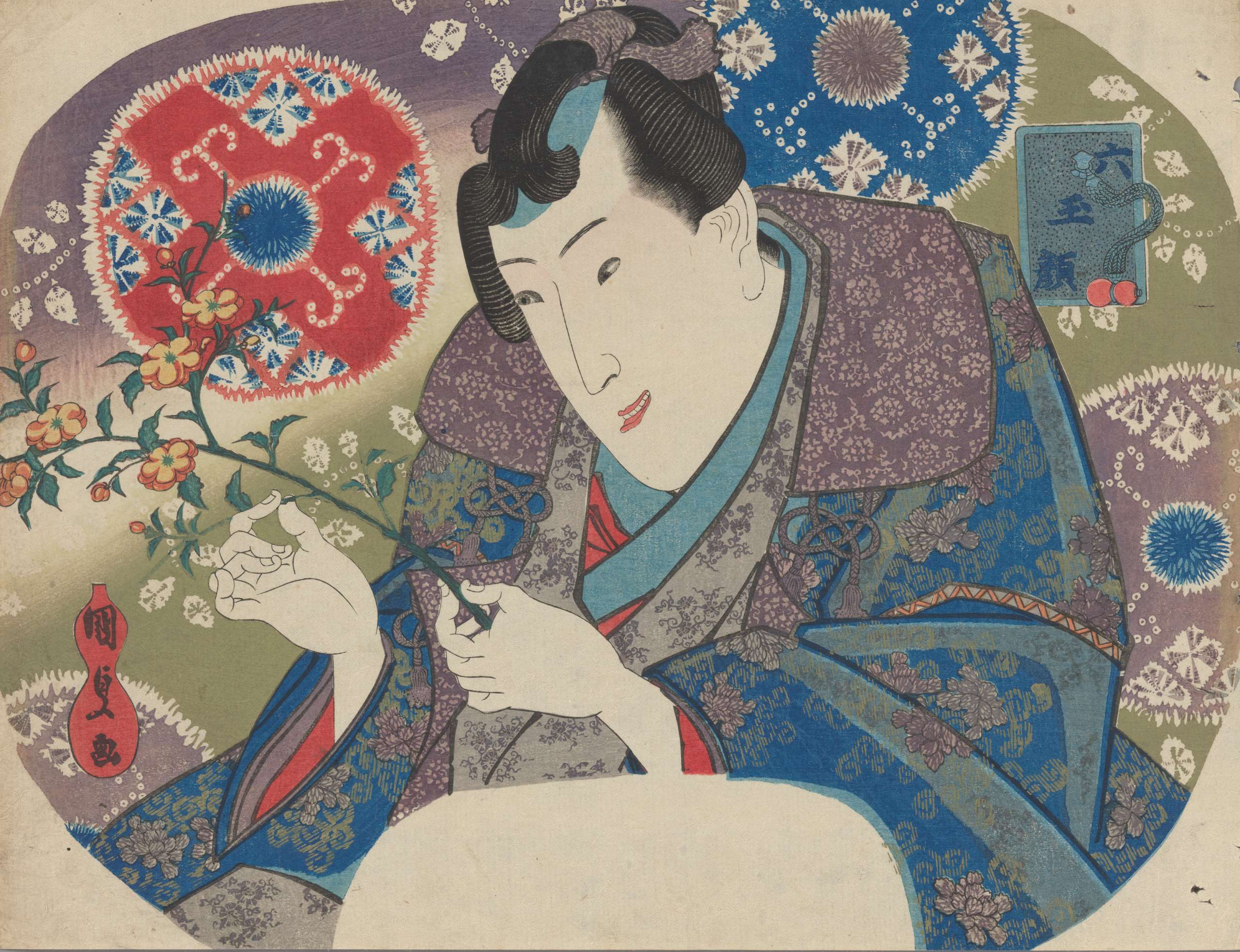 Mitsuuji with Mountain Roses (Yamabuki), from the series “Six Jewel Faces” (Mu tama-gao).
MET Accession Number:2019.3
Ref.: [LIB-2967.2022] Utagawa Kunisada: His world revisited / Catalogue 17, Exhibition March 17-21, 2021. — NY: Sebastian Izzard, LLC., 2021.
Mitsuuji with Mountain Roses (Yamabuki), from the series “Six Jewel Faces” (Mu tama-gao).
MET Accession Number:2019.3
Ref.: [LIB-2967.2022] Utagawa Kunisada: His world revisited / Catalogue 17, Exhibition March 17-21, 2021. — NY: Sebastian Izzard, LLC., 2021. -
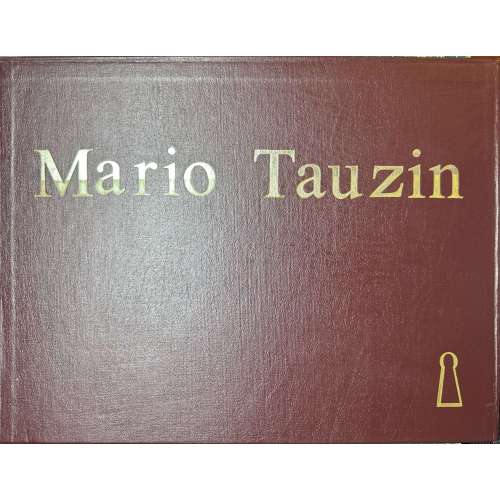 Set of 30 lithographic plates printed on watermarked Van Gelder Simili Japon wove paper, loose in two rexine-backed stiff paper wrappers, 15 in each, together in rexine portfolio with gilt lettering and keyhole on front cover. According to the seller, these are facsimiles of prints/ drawings by Mario Tauzin. Scenes from the series 'Interdit aux adultes'. No publisher indicated; printed in about 1950—a limited edition. Six of these designs used to illustrate 'Bonne à tout faire' were published by Éric Losfeld in the late 1950s (LIB-3293.2024). Dimensions: sheet 320 x 420 mm; album 330 x 430 mm. Contributor: Mario Tauzin (French, 1909 – 1979) — artist
Set of 30 lithographic plates printed on watermarked Van Gelder Simili Japon wove paper, loose in two rexine-backed stiff paper wrappers, 15 in each, together in rexine portfolio with gilt lettering and keyhole on front cover. According to the seller, these are facsimiles of prints/ drawings by Mario Tauzin. Scenes from the series 'Interdit aux adultes'. No publisher indicated; printed in about 1950—a limited edition. Six of these designs used to illustrate 'Bonne à tout faire' were published by Éric Losfeld in the late 1950s (LIB-3293.2024). Dimensions: sheet 320 x 420 mm; album 330 x 430 mm. Contributor: Mario Tauzin (French, 1909 – 1979) — artist -
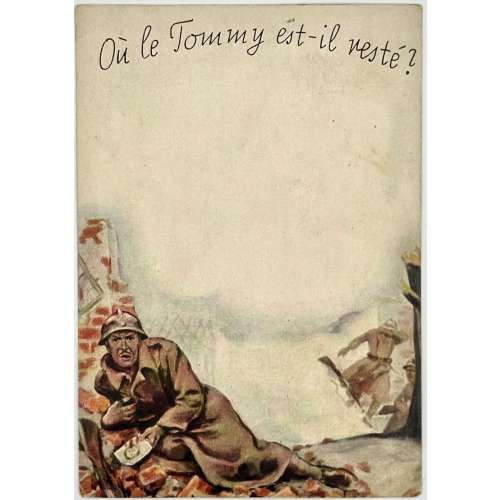 One of a series of six anti-allies propaganda cards, printed in colour, inscribed Ou le Tommy est-il resté? (Where did Tommy stay?), where Tommy is slang for a common soldier in the British Army. The postcards visibly depict French soldiers who fight and die at the western front, while the covert watermark image shows a British military having fun in a bordello. Those cards were printed in the Third Reich for France and dropped from aeroplanes to motivate French soldiers to fight against the British. Size: 149 x 104 mm
One of a series of six anti-allies propaganda cards, printed in colour, inscribed Ou le Tommy est-il resté? (Where did Tommy stay?), where Tommy is slang for a common soldier in the British Army. The postcards visibly depict French soldiers who fight and die at the western front, while the covert watermark image shows a British military having fun in a bordello. Those cards were printed in the Third Reich for France and dropped from aeroplanes to motivate French soldiers to fight against the British. Size: 149 x 104 mm -
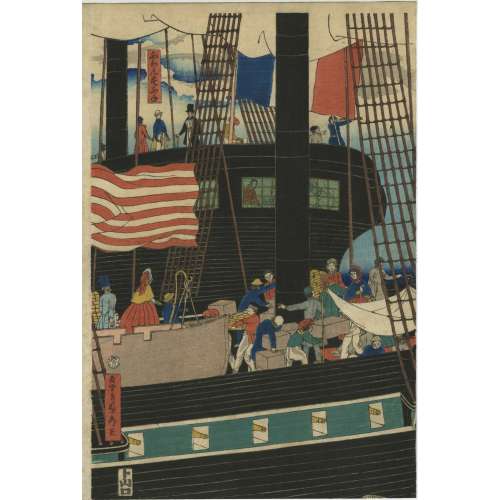 Utagawa Sadahide, a.k.a. Gountei Sadahide (Japanese, 1807 – c. 1878–1879), 五雲亭 貞秀, 歌川 貞秀, Yamaguchiya Tōbei, Yokohama kōeki seiyōjin nimotsu unsō no zu - Western traders loading cargo in Yokohama - 横浜交易西洋人荷物運送之圖, 1861, Woodblock print (nishiki-e); ink and color on paper, Horizontal Ōban Pentaptych: 5 x (37 x 25.5 cm), Alternative title: Picture of Western Traders at Yokohama Transporting Merchandise (Cat. Reisonée: Yokohama ukiyo-e, Yurindo, 1979: №50). Japanese pentaptych print shows an American ship in the harbor at Yokohama, Japan; small boats ferry cargo which is being carried up a gangplank contributing to the bustle of activity on the main deck. April, 1861. SOLD
Utagawa Sadahide, a.k.a. Gountei Sadahide (Japanese, 1807 – c. 1878–1879), 五雲亭 貞秀, 歌川 貞秀, Yamaguchiya Tōbei, Yokohama kōeki seiyōjin nimotsu unsō no zu - Western traders loading cargo in Yokohama - 横浜交易西洋人荷物運送之圖, 1861, Woodblock print (nishiki-e); ink and color on paper, Horizontal Ōban Pentaptych: 5 x (37 x 25.5 cm), Alternative title: Picture of Western Traders at Yokohama Transporting Merchandise (Cat. Reisonée: Yokohama ukiyo-e, Yurindo, 1979: №50). Japanese pentaptych print shows an American ship in the harbor at Yokohama, Japan; small boats ferry cargo which is being carried up a gangplank contributing to the bustle of activity on the main deck. April, 1861. SOLD -
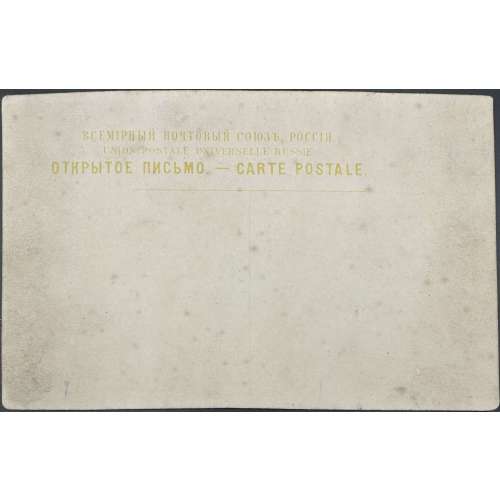 Ten postcards 90 x 140 mm, text in yellow "ВСЕМIРНЫЙ ПОЧТОВЫЙ СОЮЗЪ. РОССIЯ. | UNION POSTALE UNIVERSELLE RUSSIE. | ОТКРЫТОЕ ПИСЬМО. — CARTE POSTALE. || On the reverse, a blue ink woodcut image is printed in the upper left corner, and a blue ink numbered image title is in the bottom centre. Holding the postcard against the backlight reveals a hidden image of an indecent nature (erotic). The use of Latin characters "R" and "N" instead of Russian "Р" and "Н" suggests that the cards were produced in Europe, probably in France. Inscriptions: 1. ПЕRВЫЕ ДNИ; 2. ПОRА ЛЮБВИ; 3. ВЪ ЛЮДИ; 4. КЪ "СВОБОДNОМУ ИСКУССТВУ"; 5. "СВОБОДNЫЙ ТRУДЪ; 6. БЕЗЪ ГОRЯ И ПЕЧАЛИ; 7. NАЗАДЪ КЪ "СВОБОДNОЙ ЛЮБВИ"; 8. ВСЕ ЧТО ОСТАЛОСЬ!; 9. БЕЗЪ КRОВА И ПRИСТАNИЩА; 10. ИЗЪ ЗА ХЛѢБА.
Ten postcards 90 x 140 mm, text in yellow "ВСЕМIРНЫЙ ПОЧТОВЫЙ СОЮЗЪ. РОССIЯ. | UNION POSTALE UNIVERSELLE RUSSIE. | ОТКРЫТОЕ ПИСЬМО. — CARTE POSTALE. || On the reverse, a blue ink woodcut image is printed in the upper left corner, and a blue ink numbered image title is in the bottom centre. Holding the postcard against the backlight reveals a hidden image of an indecent nature (erotic). The use of Latin characters "R" and "N" instead of Russian "Р" and "Н" suggests that the cards were produced in Europe, probably in France. Inscriptions: 1. ПЕRВЫЕ ДNИ; 2. ПОRА ЛЮБВИ; 3. ВЪ ЛЮДИ; 4. КЪ "СВОБОДNОМУ ИСКУССТВУ"; 5. "СВОБОДNЫЙ ТRУДЪ; 6. БЕЗЪ ГОRЯ И ПЕЧАЛИ; 7. NАЗАДЪ КЪ "СВОБОДNОЙ ЛЮБВИ"; 8. ВСЕ ЧТО ОСТАЛОСЬ!; 9. БЕЗЪ КRОВА И ПRИСТАNИЩА; 10. ИЗЪ ЗА ХЛѢБА. -
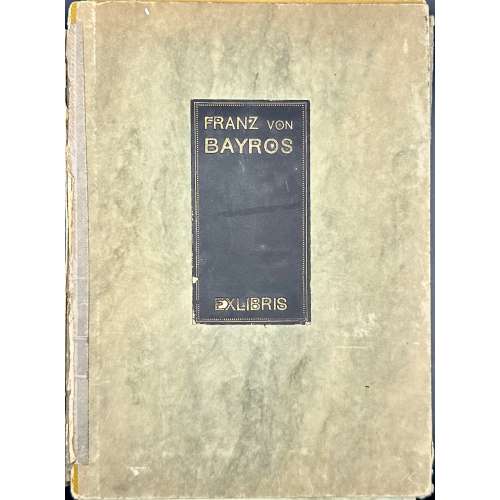 A set of 49 prints, heliogravures and etchings, tipped-in on 285 x 257 mm grey cards, in a green marbled folder with a gilt-lettered black label to the front. No publisher, no place, no year (s.l., s.n., s.d.), printed in circa 1910.
A set of 49 prints, heliogravures and etchings, tipped-in on 285 x 257 mm grey cards, in a green marbled folder with a gilt-lettered black label to the front. No publisher, no place, no year (s.l., s.n., s.d.), printed in circa 1910.- Vlastimil Blažek (Czech, 1878 – 1950): heliogravure, sheet 180 x 137 mm, plate 152 x 114 mm; laid paper, black sepia ink; unsigned.
- Ex libris Gerhard Wunderlich (architect in Dresden): heliogravure, sheet 205 x 150 mm, plate 158 x 115 mm; wove paper, brown sepia ink; inscription: heliogravure, sheet 180 x 137 mm, plate 152 x 114 mm; laid paper, sepia ink; inscription to top “Es ist alles so eng”; signed “F (backwards). Bayros”.
- Ex libris William Lipka: heliogravure, sheet 140 x 125 mm, plate 112 x 98 mm; laid paper, black sepia ink; signature hardly legible.
- Nikolaus Schindler (amateur photographer in Vienna): heliogravure, sheet 142 x 150 mm, plate 110 x 117 mm; laid paper, black sepia ink; unsigned.
- Sussy de Coiquard: heliogravure, sheet 160 x 140 mm, plate 128 x 110 mm; laid paper, black sepia ink; unsigned.
- Illegible, looks like “Vielluer Febréy”: heliogravure, sheet 120 x 109 mm, plate 93 x 85 mm; laid paper, black, sepia ink; signed “F (backwards). Bayros:”.
- Ex libris Erich Liebermann-Rosswiese (Greman-Jewish, 1886 – 1942): heliogravure, sheet 180 x 139 mm, plate 118 x 88 mm; wove paper, black sepia ink; unsigned.
- Ex libris Dr. phil. Rudolf Ludwig: before letters, heliogravure, sheet 150 x 132 mm, plate 120 x 110 mm; laid paper, black sepia ink; unsigned. See [LIB-3258.2023] John Cleland. Die Memoiren der Fanny Hill. — Paphos [i.e. Vienna]: C. W. Stern, 1906.
- Unidentified: before letters, heliogravure, sheet 150 x 115 mm, plate 113 x 88 mm; laid paper, black sepia ink; signed “F. Bayros” in the manuscript. Circumstantial evidence tells that this bookplate belongs to someone A.W.(Artur Wolf). See №22.
- Lulu. Monachia. Gest. v. Ritter Dialekt und Junker Erich: heliogravure, sheet 204 x 152 mm, plate 160 x 118 mm; wove paper, black sepia ink; unsigned. See №20.
- Kellner Jstván: (István): heliogravure, sheet 118 x 100 mm, plate 85 x 70 mm; laid paper, black sepia ink; signed “Franz Bayros” in the script (hardly legible).
- Adyton: heliogravure, sheet 170 x 130 mm, plate 113 x 85 mm; wove paper, black, sepia ink; signed “F (backwards). Bayros”.
- 13.Ex libris George Arthur Buhl (American, 1883 – 1959): heliogravure, sheet 166 x 140 mm, plate 120 x 92 mm; wove paper, black sepia ink; inscription “!I will! | !And I can!”; bust inscribed “T. Carlyle”; signed “F (backwards). Bayros” (hardly legible).
- Ex-Libris Heinrich und Lise Fuhrmann: heliogravure, sheet 165 x 149 mm, plate 120 x 103 mm; wove paper, black sepia ink; signed “F (backward). Bayros”; inscription “So schaff ich am sausenden Webstuhl der Zeit und wirke der Gottheit lebendiges Kleid” (from ‘Faust’ by Goethe).
- Ex libris Gerhard Wunderlich (architect in Dresden): heliogravure, sheet 165 x 137 mm, plate 135 x 105 mm; laid paper, black, sepia ink; signed “F (backwards). Bayros”.
- Ex Libris Walther u. Amelia Fahrenhorst; Walter Fahrenhorst (German, 1871 – 1938): heliogravure, sheet 165 x 140 mm, plate 128 x 95 mm; wove paper, black sepia ink; signed “F. Bayros” in the manuscript. The inscription behind the strings: NITOR (lat. beauty, glamour).
- Ex Libris Margot Lewknecht; heliogravure, sheet 145 x 140 mm, plate 128 x 118 mm; laid paper, black sepia ink; signed “F. Bayros”.
- Ex Libris Walther Heinisch (publisher in Carlsbad); heliogravure, sheet 185 x 145 mm, plate 140 x 110 mm; wove paper, sanguine; male bust with an inscription to the base: “Arnold Boeklin” / Arnold Böcklin (Swiss, 1827 – 1901); inscription: “mit gêru scal man geba infâhan” – a line from Hildebrandslied, the earliest poetic text in German. Unsigned.
- Bookplate with music score GGDBGC; heliogravure, sheet 125 x 135 mm, plate 100 x 110 mm, with monogram «HCJ»; laid paper, brown sepia ink; signed “F. Bayros”.
- Bookplate with inscription: Lulu aus Praga | Gest v. Ritter Dialekt / Monachia / Monachia / und Junker Erich; heliogravure, sheet 182 x 147 mm, plate 160 x 120 mm, image 122 x 105 mm; wove paper, bluish-black sepia ink; unsigned. See №10.
- Bookplate, no inscription; heliogravure, laid paper, sepia ink, sheet 148 x 127 mm, image 84 x 79 mm; signed F. Bayros in the manuscript beneath the image.
- Ex libris Artur Wolf: heliogravure, laid paper, sepia ink, sheet 170 x 150 mm, image 120 x 105 mm; signed F. Bayros in the manuscript to the frame of the image. See №9.
- Ex Libris E. K. Weigl: heliogravure, laid paper, sepia ink, sheet 139 x 121 mm, plate 112 x 97 mm; unsigned; inscription above male portrait: “LEONARDO”.
- Ex libris Dr. A. Bergmann: heliogravure, wove paper, sepia ink; sheet 180 x 140 mm, plate 130 x 105 mm; signed F. Bayros in the manuscript.
- Grete Cäcilie (monogram “PS”): heliogravure, laid paper, sepia ink, sheet 161 x 130 mm, plate 128 x 103 mm, signature illegible.
- Emma Steigleder: heliogravure, laid paper, black ink, sheet 181 x 141 mm, plate 158 x 117 mm, signed F. Bayros in the manuscript. Inscription “Si vis amari, ama! Seneca” [If you want to be loved, love] to the attic of the arch.
- Bruno Fischer: heliogravure, laid paper, sepia ink, sheet 186 x 145 mm, plate 155 x 116 mm, signed “F (backward). Bayros”. Inscription to bottom “Gehl Weck’ ihn nicht auf seien wir froh dass er einmal schläft!”
- Harnasch: heliogravure, wove paper, sepia ink; unsigned; sheet 140 x 132 mm, plate 100 x 85 mm; unsigned.
- Eduard Klampfl: heliogravure, laid paper, sepia ink, sheet 165 x 145 mm, plate 135 x 110 mm, signed “F (backwards). Bayros”; portrait bust of the composer Richard Wagner (German, 1813 –1883).
- Jorge Monsalvatje: heliogravure, wove paper, sepia ink; sheet 189 x 160 mm, plate 150 x 115 mm; signed F. Bayros in the manuscript.
- E. K. W.: wove paper, sepia ink; sheet 150 x 120 mm; signed “Bayros”.
- Unidentified bookplate: wove paper, sepia ink; sheet 150 x 120 mm; signed “F. Bayros 09” in the manuscript.
- Ex-Libris Helene and Emil Lemberger: heliogravure (or soft ground etching), laid paper, sepia ink, sheet 180 x 163 mm, plate 150 x 130 mm, signed “F. Bayros” in the manuscript.
- M. Z.: wove paper, sepia ink; sheet 130 x 170 mm, plate 90 x 120 mm; signed “F (backwards) Bayros”.
- Ex libris Frankl Frigyes Vilmos: heliogravure (or soft ground etching), laid paper, sepia ink, sheet 140 x 148 mm, unsigned. Frigyes Frankl, born in Tejfalu, Szlovákia, died in 1943.
- Ex libris Anton Bürck: heliogravure, wove paper, sepia ink; sheet 170 x 137 mm, plate 123 x 104 mm; unsigned. Anton Burck (German,1881 – 1951) of Palatinate, Bavaria.
- Aus den büchern A. W.: heliogravure, laid paper, sepia ink, sheet 152 x 136 mm, plate 120 x 105 mm, signed “F. Bayros” in the manuscript.
- Ex libris Hans Hickl: heliogravure, laid paper, sepia ink, sheet 150 x 125 mm, plate 115 x 95 mm, signed “Ω”.
- Ex libris Karl Wehle: soft ground etching, laid paper, brown sepia ink, sheet 107 x 90 mm, plate 80 x 65 mm, inscription “Gut!” in the centre; unsigned. Karl Wehle (Austrian, 1901 – 1933)
- Ex libris Dr. Paul Berger: etching, laid paper, black ink, sheet 140 x 115 mm, plate 115 x 85 mm, signed “F (backwards). Bayros”.
- Unidentified bookplate: etching, laid paper, black ink, sheet 145 x 115 mm, plate 85 x 70 mm, unsigned.
- Ex Bibliotheca Erotica Carl Georg von Maassen: soft ground etching, india paper, black ink, sheet 76 x 78 mm, signed “FB”.
- Ex Bibliotheca Erotica Carl Georg von Maassen: soft ground etching, india paper, black ink, sheet 79 x 79 mm, signed “F. von Bayros”.
- Paul Mixa: soft ground etching, laid paper, sanguine ink, sheet 122 x 111 mm, plate 90 x 85 mm, inscription: “Gerne hör’ich wenn du singest und ich horche wenn du schweigest” [I like to hear when you sing and I listen when you are silent].
- Ex libris Drs Q. M. Vyskocil.: etching, laid paper, sanguine ink, sheet 141 x 115 mm, plate 115 x 75 mm, inscription: “MIT REINEN HAENDEN” [with pure hands], signed “F. Bayros” in the manuscript.
- Ex libris Andrée Bearn de Riquer: soft ground etching, laid paper, sanguine ink, sheet 136 x 88 mm, plate 100 x 62 mm, signed “F (backwards). Bayros”. Andrée Béarn [Marguerite Laborde] (French, 1880 – 1973), spouse of Alexandre de Riquer (Catalan, 1856 – 1920).
- Ex musicis Drs Blažek VL: etching, wove paper, sanguine ink, sheet 141 x 116 mm, plate 115 x 90 mm, inscription: “MIT REINEN HAENDEN” [with pure hands], signed “F. Bayros” in the manuscript. See Vlastimil Blažek (Czech, 1878 – 1950) № 1 in this series.
- Ex libris Paul Lindenberg: etching, wove paper, sanguine ink, sheet 130 x 114 mm, plate 95 x 90 mm, image 80 x 72 mm, inscription: “ad pios usus” (for pious uses); signed with monogram “F (backwards). B”.
- Unidentified bookplate: heliogravure, laid paper, sanguine ink, sheet 150 x 131 mm, plate 120 x 100 mm, signed “F. Bayros” in the manuscript.
-
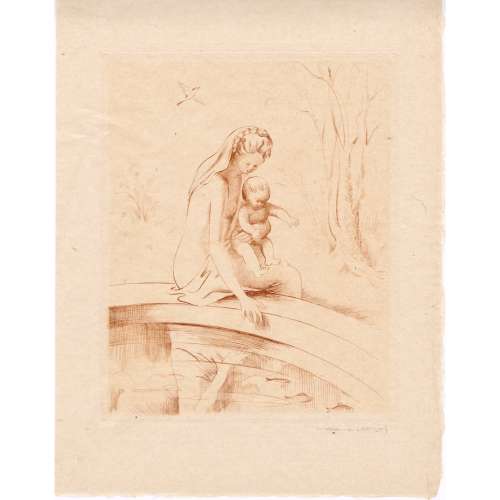 Set of 10 etchings (9 in passe-partout) printed in sanguine on the mother of pearl paper (japon nacre) from the album of 12 prints titled “Jeunesse”, presented by Gérard D'Houville (pen name of Marie de Régnier, née de Heredia) and published by La Tradition in 1945. It was a limited edition of 532 copies, some coloured on Arches paper and some as these set. Plates signed by the artist in pencil below the plate mark. The album cover is missing. Title-page: JEUNESSE | 12 EAUX-FORTES ORIGINALES | DE | MARIANNE CLOUZOT | PRÉSENTÉES | PAR | GÉRARD D'HOUVILLE | {publisher’s device} | LA TRADITION | 1945 || Dimensions: mat 330 x 255 mm; window 225 x 180 mm; sheet 280 x 220 mm; plate 220 x 170 mm. Contributors: Marianne Clouzot (French, 1908 – 2007) – artist Marie de Régnier [Marie de Heredia, Gérard d'Houville] (French, 1875 – 1963) – editor
Set of 10 etchings (9 in passe-partout) printed in sanguine on the mother of pearl paper (japon nacre) from the album of 12 prints titled “Jeunesse”, presented by Gérard D'Houville (pen name of Marie de Régnier, née de Heredia) and published by La Tradition in 1945. It was a limited edition of 532 copies, some coloured on Arches paper and some as these set. Plates signed by the artist in pencil below the plate mark. The album cover is missing. Title-page: JEUNESSE | 12 EAUX-FORTES ORIGINALES | DE | MARIANNE CLOUZOT | PRÉSENTÉES | PAR | GÉRARD D'HOUVILLE | {publisher’s device} | LA TRADITION | 1945 || Dimensions: mat 330 x 255 mm; window 225 x 180 mm; sheet 280 x 220 mm; plate 220 x 170 mm. Contributors: Marianne Clouzot (French, 1908 – 2007) – artist Marie de Régnier [Marie de Heredia, Gérard d'Houville] (French, 1875 – 1963) – editor -
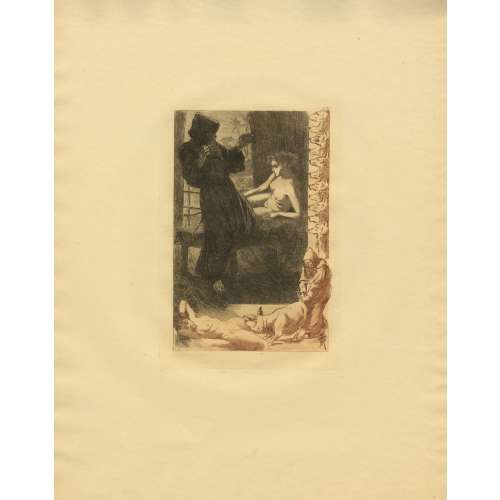 Set of 21 etchings by Martin van Maele for the English edition of ‘Thais’ by Anatole France published in London by Charles Carrington in 1901. Printed on vowe paper without a watermark in two colours with the black image and sepia historiated border. All etchings are inscribed with the artist's monogram; one of the etchings bears inscriptions ORGUEIL, LUXURE, DOUTE (mirror image). Dimensions: sheet: 317 x 250 mm; plate: 170 x 115 mm; image: 155 x 100 mm. Catalogue raisonné: S. A. Perry: № 64. Per Perry, the edition was printed in 500 copies on 'handmade paper watermarked 'Van Gelder'. Contributor: Martin van Maële [Martin, Maurice François Alfred] (French, 1863 – 1926)
Set of 21 etchings by Martin van Maele for the English edition of ‘Thais’ by Anatole France published in London by Charles Carrington in 1901. Printed on vowe paper without a watermark in two colours with the black image and sepia historiated border. All etchings are inscribed with the artist's monogram; one of the etchings bears inscriptions ORGUEIL, LUXURE, DOUTE (mirror image). Dimensions: sheet: 317 x 250 mm; plate: 170 x 115 mm; image: 155 x 100 mm. Catalogue raisonné: S. A. Perry: № 64. Per Perry, the edition was printed in 500 copies on 'handmade paper watermarked 'Van Gelder'. Contributor: Martin van Maële [Martin, Maurice François Alfred] (French, 1863 – 1926) -
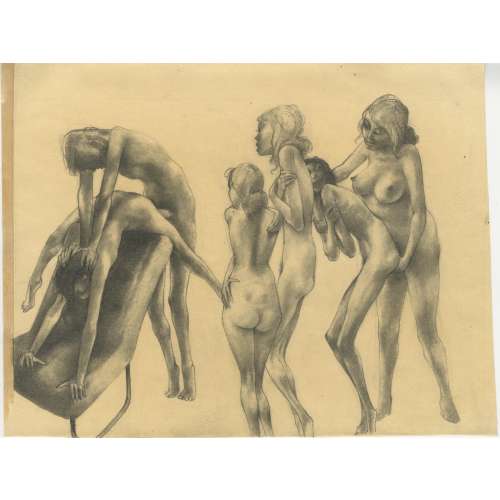 Graphite on wove paper, 217 x 284 mm, black ink stamp to verso: “Prof O. R. Schatz | Wien II, Gr. Mohreng 3b | Tel.: 55 82 566”. Unsigned, attributed to Otto Rudolf Schatz (Austrian, 1900 – 1961).
Graphite on wove paper, 217 x 284 mm, black ink stamp to verso: “Prof O. R. Schatz | Wien II, Gr. Mohreng 3b | Tel.: 55 82 566”. Unsigned, attributed to Otto Rudolf Schatz (Austrian, 1900 – 1961). -
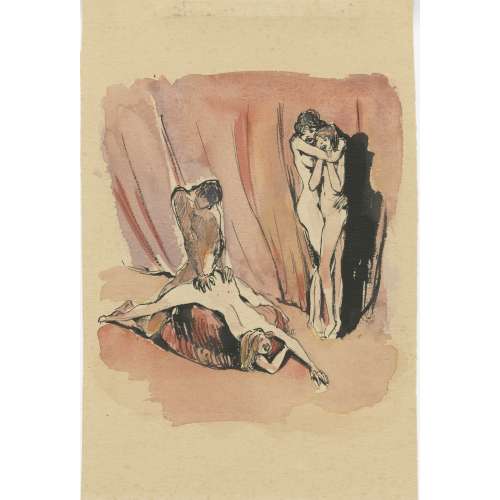 Watercolour on wove paper, 243 x 161 mm, black ink stamp to verso: “Nachlaß O R SCHATS”. Attributed to Otto Rudolf Schatz (Austrian, 1900 – 1961).
Watercolour on wove paper, 243 x 161 mm, black ink stamp to verso: “Nachlaß O R SCHATS”. Attributed to Otto Rudolf Schatz (Austrian, 1900 – 1961). -
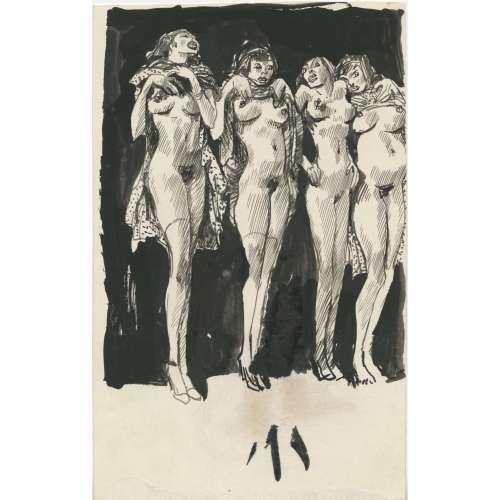 Drawing on both sides; Pen and wash, india ink, gouache, on cardboard, 225 x 140 mm, black ink stamp to verso: “Nachlaß O R SCHATS”, remnants of hinges. Attributed to Otto Rudolf Schatz (Austrian, 1900 – 1961).
Drawing on both sides; Pen and wash, india ink, gouache, on cardboard, 225 x 140 mm, black ink stamp to verso: “Nachlaß O R SCHATS”, remnants of hinges. Attributed to Otto Rudolf Schatz (Austrian, 1900 – 1961). -
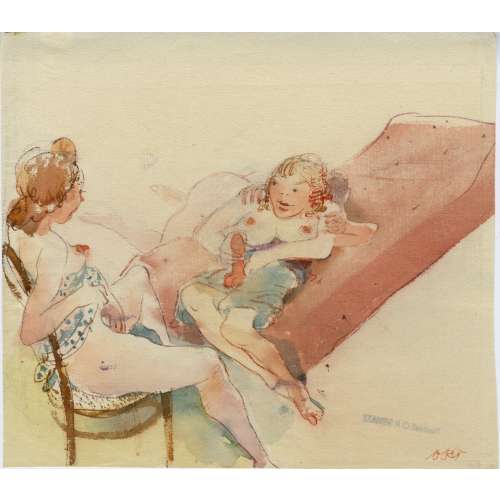 Watercolour on laid paper, 198 x 225 mm, signed or stamped in orange ink “ORS” to recto [Otto Rudolf Schatz (Austrian, 1900 – 1961)]; black ink stamp: “Nachlaß O R SCHATS”, pencil “ss” in the bottom left corner, and remnants of a hinge on the upper right to verso.
Watercolour on laid paper, 198 x 225 mm, signed or stamped in orange ink “ORS” to recto [Otto Rudolf Schatz (Austrian, 1900 – 1961)]; black ink stamp: “Nachlaß O R SCHATS”, pencil “ss” in the bottom left corner, and remnants of a hinge on the upper right to verso. -
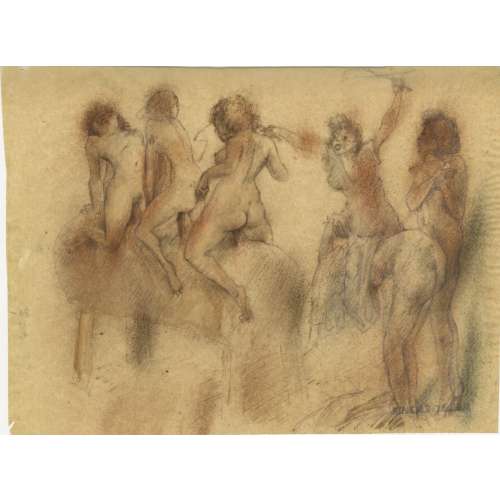 Pencil, pen and ink wash on india paper, 170 x 228 mm, black ink stamp to verso: “Nachlaß O R SCHATS”. Unsigned, attributed to Otto Rudolf Schatz (Austrian, 1900 – 1961).
Pencil, pen and ink wash on india paper, 170 x 228 mm, black ink stamp to verso: “Nachlaß O R SCHATS”. Unsigned, attributed to Otto Rudolf Schatz (Austrian, 1900 – 1961). -
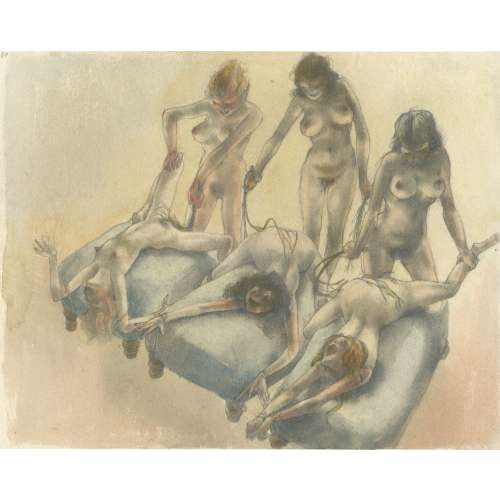 Watercolour on laid paper watermarked “HOLLAND”, 255 x 324 mm, number “10” ms pencil in the upper left corner, remnants of hinges to verso; unsigned. Attributed to Otto Rudolf Schatz (Austrian, 1900 – 1961).
Watercolour on laid paper watermarked “HOLLAND”, 255 x 324 mm, number “10” ms pencil in the upper left corner, remnants of hinges to verso; unsigned. Attributed to Otto Rudolf Schatz (Austrian, 1900 – 1961). -
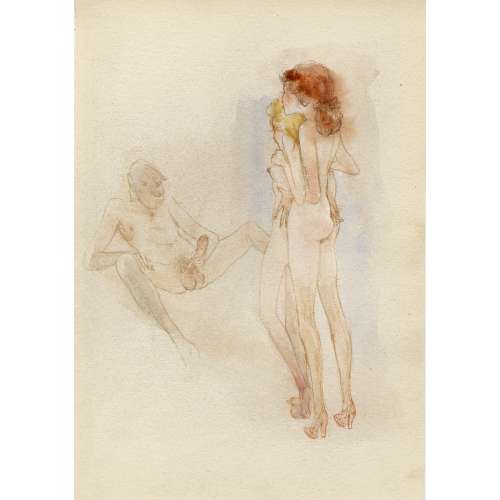 Watercolour on thick wove paper, unsigned. Attributed to Otto Rudolf Schatz (Austrian, 1900 – 1961). Size: 305 x 212 mm.
Watercolour on thick wove paper, unsigned. Attributed to Otto Rudolf Schatz (Austrian, 1900 – 1961). Size: 305 x 212 mm. -
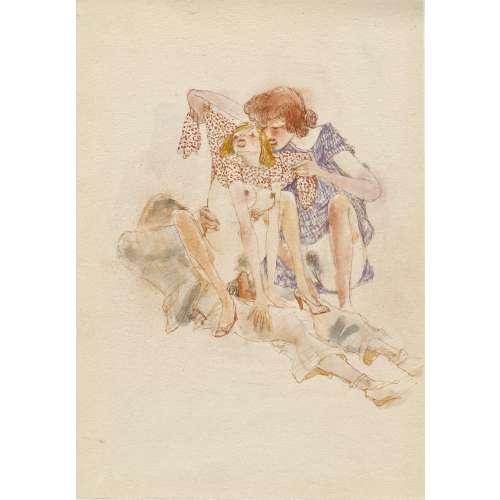 Watercolour on thick wove paper, unsigned. Attributed to Otto Rudolf Schatz (Austrian, 1900 – 1961). Size: 305 x 212 mm.
Watercolour on thick wove paper, unsigned. Attributed to Otto Rudolf Schatz (Austrian, 1900 – 1961). Size: 305 x 212 mm. -
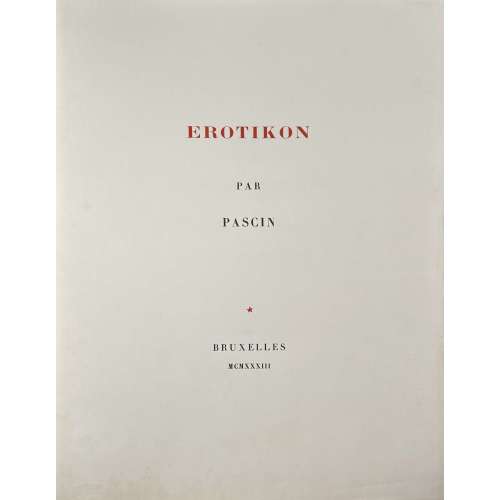 A portfolio of nine heliogravures after Jules Pascin. Cloth-backed cardboard portfolio 420 x 335 mm with 9 heliogravures on slightly tinted india paper, each numbered in pencil and mounted into a passe-partout 410 x 318 mm. Copy № 25 out of 40 printed on india (chine) paper. Copy № 25 of 40. Title (red and black): EROTIKON | PAR | PASCIN | ★ | BRUXELLES | MCMXXXIII || Limitation: CET | ALBUM | A ÉTÉ TIRÉ | A | QUARANTE ET UN EXEMPLAIRES | NUMÉROTÉS | DONT | UN EX. SUR PAPIER ANCIEN | & | QUARANTE EX. SUR CHINE | No (ms 25/40) || Catalogue raisonné: Dutel III № 1498. Seller's description:Neun Heliogravüren. 1933. Meist ca. 30 : 35 cm. Nummeriert. Exemplar 25/40 (Gesamtauflage 41). – Die Heliogravüren auf leicht getöntem China, jedes Blatt mit Bleistift nummeriert und in Passepartouts montiert. – Die neun Passepartouts eingelegt in zwei Büttenumschläge, einer mit Titel und dem nummerierten Auflagenvermerk, der zweite unbedruckt, ferner Büttenumschlag mit Titel in Rotdruck und Halbleinenchemise. – Die Heliogravüren erschienen 1933, drei Jahre nach Pascins Tod bei Daragnes in Paris mit der fingierten Angabe »Brüssel«. – Das berühmte Mappenwerk bildet eine der großen Seltenheiten der erotischen Kunst. Die Motive Pascins beschreibt das Bilderlexikon als »eine Art ›Boheme-Rokoko im Montmartre-Milieu‹« und lobt den Künstler: »Er ist ein außerordentlicher Zeichner, der es versteht, bei allem Zynismus, der seinen exhibitionistischen Charakter nicht verleugnet, auf diesem Kulturdünger eine neuartige Blume voll graziöser Schönheit erblühen zu lassen.« Mappe: 42 : 33,5 cm. – Der äußere Büttenumschlag mit leichtem Wasserrand. – Zwei Heliogravüren minimal stockfleckig, sonst tadellos und absolut vollständig. Dutel 1498 (mit Auflagenvarianten). – Der kalte Blick S. 198ff. – Bilderlexikon II, 718.
A portfolio of nine heliogravures after Jules Pascin. Cloth-backed cardboard portfolio 420 x 335 mm with 9 heliogravures on slightly tinted india paper, each numbered in pencil and mounted into a passe-partout 410 x 318 mm. Copy № 25 out of 40 printed on india (chine) paper. Copy № 25 of 40. Title (red and black): EROTIKON | PAR | PASCIN | ★ | BRUXELLES | MCMXXXIII || Limitation: CET | ALBUM | A ÉTÉ TIRÉ | A | QUARANTE ET UN EXEMPLAIRES | NUMÉROTÉS | DONT | UN EX. SUR PAPIER ANCIEN | & | QUARANTE EX. SUR CHINE | No (ms 25/40) || Catalogue raisonné: Dutel III № 1498. Seller's description:Neun Heliogravüren. 1933. Meist ca. 30 : 35 cm. Nummeriert. Exemplar 25/40 (Gesamtauflage 41). – Die Heliogravüren auf leicht getöntem China, jedes Blatt mit Bleistift nummeriert und in Passepartouts montiert. – Die neun Passepartouts eingelegt in zwei Büttenumschläge, einer mit Titel und dem nummerierten Auflagenvermerk, der zweite unbedruckt, ferner Büttenumschlag mit Titel in Rotdruck und Halbleinenchemise. – Die Heliogravüren erschienen 1933, drei Jahre nach Pascins Tod bei Daragnes in Paris mit der fingierten Angabe »Brüssel«. – Das berühmte Mappenwerk bildet eine der großen Seltenheiten der erotischen Kunst. Die Motive Pascins beschreibt das Bilderlexikon als »eine Art ›Boheme-Rokoko im Montmartre-Milieu‹« und lobt den Künstler: »Er ist ein außerordentlicher Zeichner, der es versteht, bei allem Zynismus, der seinen exhibitionistischen Charakter nicht verleugnet, auf diesem Kulturdünger eine neuartige Blume voll graziöser Schönheit erblühen zu lassen.« Mappe: 42 : 33,5 cm. – Der äußere Büttenumschlag mit leichtem Wasserrand. – Zwei Heliogravüren minimal stockfleckig, sonst tadellos und absolut vollständig. Dutel 1498 (mit Auflagenvarianten). – Der kalte Blick S. 198ff. – Bilderlexikon II, 718. -
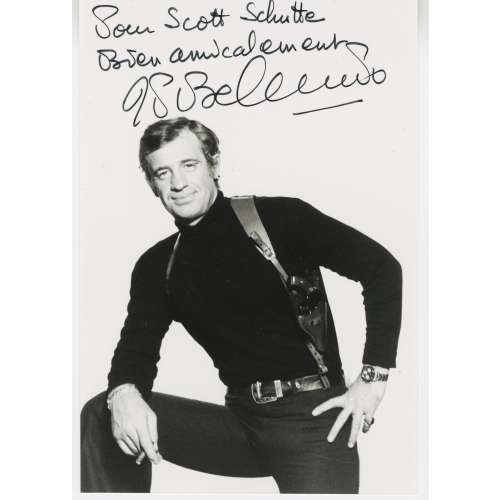 Three-quarter waist portrait of French actor Jean-Paul Belmondo in the film Peur sur la Ville, directed by Henri Verneuil in 1975. Autographed in black ink on a light area of the image above the head: “Pour Scott Schutte | Bien amicalement | J.P. Belmondo”. Paper watermarked "Agfa" in a diamond. Dimensions: 147 x 100 mm
Three-quarter waist portrait of French actor Jean-Paul Belmondo in the film Peur sur la Ville, directed by Henri Verneuil in 1975. Autographed in black ink on a light area of the image above the head: “Pour Scott Schutte | Bien amicalement | J.P. Belmondo”. Paper watermarked "Agfa" in a diamond. Dimensions: 147 x 100 mm


